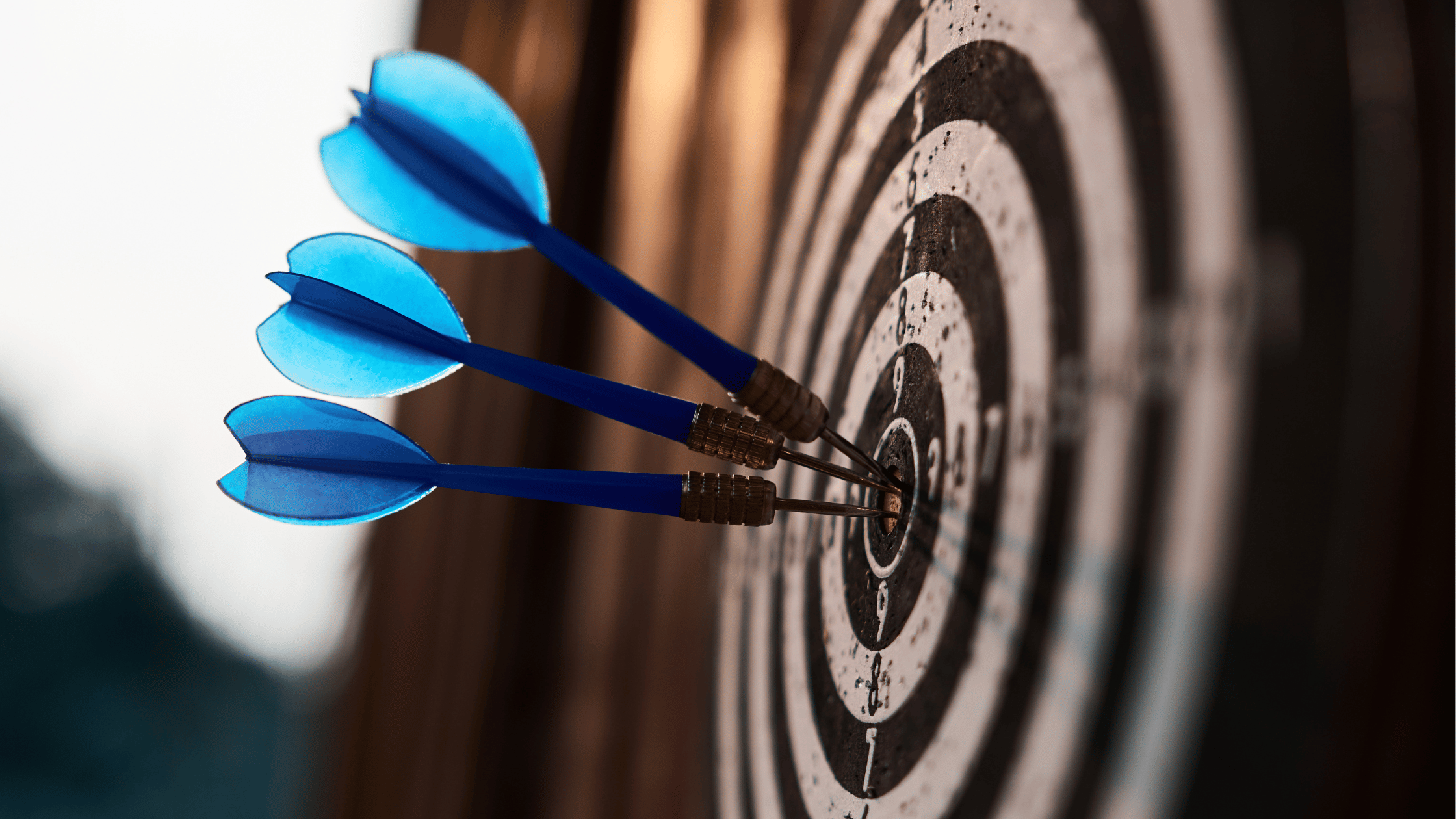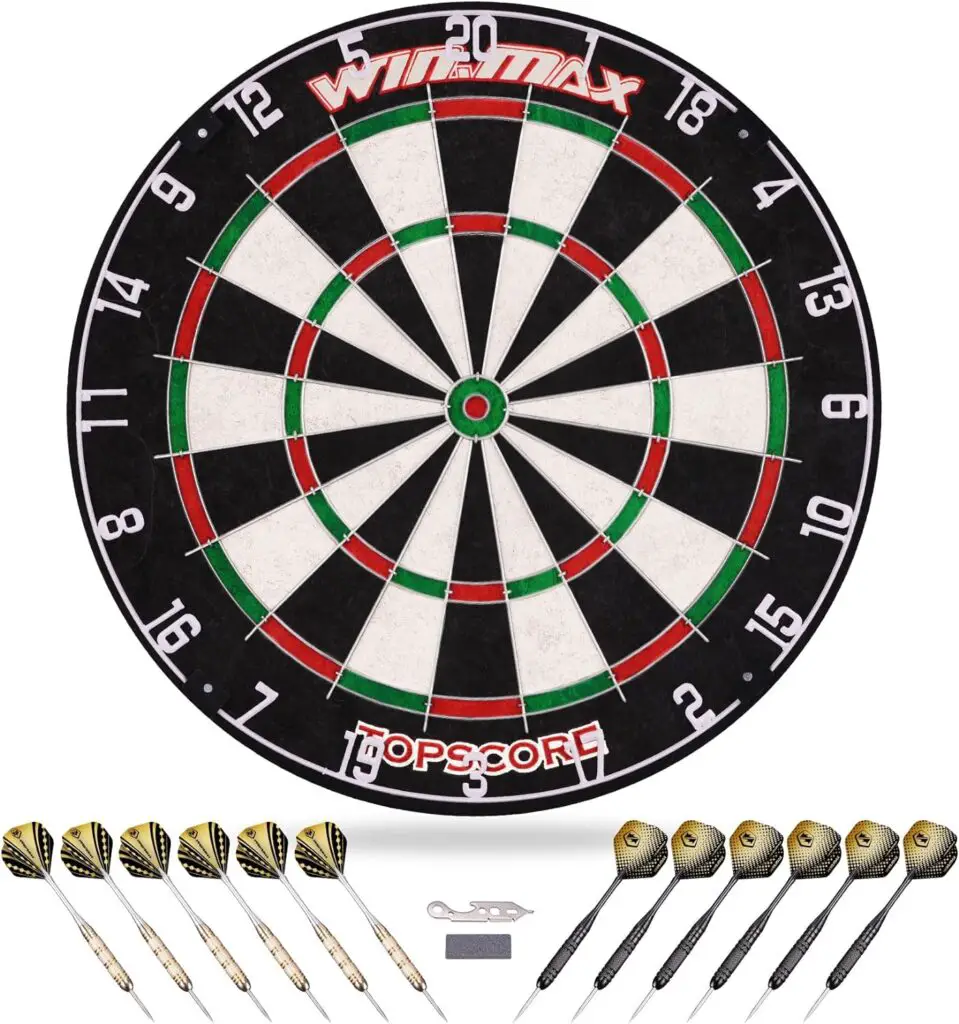Beginner’s Guides to Darts as a Hobby: Mastering the Basics and Beyond
Darts is a precision sport where you can hone your skills without any fancy equipment—just a set of darts and a board. Playing darts involves skill, accuracy, and a bit of strategic thinking, making it a great hobby if you’re looking to challenge yourself mentally as well as physically.
Whether you’re aiming to become a competitive player or just looking for a fun activity to do with friends, darts offers a blend of concentration and camaraderie.
To start your journey in darts, understanding the basics is crucial. This includes familiarizing yourself with the equipment needed, learning the standard rules of the game, and mastering the art of throwing.
The dart board itself is your canvas, divided into numbered segments that dictate the game’s scoring, while the darts are your tools, crafted with precision to hit the targeted spots accurately.
Developing a consistent throwing stance and technique is key to becoming proficient in darts. It’s not just about throwing with force; finesse, posture, and practice all play integral roles. To improve your game, consider adopting various practice routines, paying close attention to your grip, aim, and follow-through. Making the transition from a novice to a skilled darts player is a rewarding process that deepens your appreciation for the game’s subtleties.
Understanding the Basics of Darts

Embarking on darts as a hobby requires familiarity with the dartboard, the equipment used in the game, and the fundamental rules that guide play. This section will provide you with a concise understanding of these core elements, so you can start your journey with confidence.
The Dartboard
A traditional dartboard is divided into 20 numbered sections, scoring from 1 to 20 points. The outer ring scores double points, while the inner ring scores triple. The bullseye, or the center of the board, has two sections: the outer bull scores 25 points and the inner bull, also known as the double bull, scores 50 points. The dartboard should be mounted with the bullseye at 5 feet 8 inches from the floor, which is eye level for a six-foot person.
For a beginner, it’s important to start with a quality bristle dartboard, which is made of sisal fibers and has the self-healing property needed for steel-tip darts. Alternatively, if you prefer a modern approach, an electronic dartboard can be used with soft-tip darts and is ideal for casual play and practice.
Dart Equipment
The primary pieces of dart equipment include the dart itself, which is comprised of four main parts: the tip, the barrel, the shaft, and the flight. Steel-tip darts are used with bristle dartboards and are generally heavier. They require a fairly consistent throwing technique to ensure they stick properly. Soft-tip darts are used with electronic boards and are lighter with a flexible plastic tip.
When selecting your darts, focus on the grip and weight that feel comfortable in your hand. The weight affects the throw’s arc and stability in flight, while the grip can influence the release and precision.
Rules of the Game
The basic rules of darts revolve around taking turns to throw a set of three darts per round. The objective is to reduce a fixed score, often starting at 501 or 301, to exactly zero, with the final dart landing in either a numbered section or the bullseye. The complexity of the game increases with the rule that the final dart must land in a double or the bullseye to win, known as a ‘double-out’.
In order to play correctly, you should stand behind the throwing line, also called the “oche,” which is 7 feet 9.25 inches from the dartboard. Each player’s score must be carefully tracked, and strategic planning is key, especially in choosing which sections of the board to aim for as your score diminishes.
Developing Your Dart Throwing Technique

Improving your dart throwing technique hinges on perfecting certain key elements: your stance, the way you grip the dart, and your throwing motion. Mastery of these will lead to greater consistency and accuracy over time.
Stance and Grip
Your stance is foundational for stable and accurate dart throws. Stand with your leading foot slightly forward and your body angled to the dartboard.
This position provides stability and alignment. The grip on the dart should be firm yet relaxed; a relaxed grip is essential for controlled movement and prevents the dart from veering off course.
- Feet Position: Front foot slightly forward, back foot for support
- Body Alignment: Sideways to the board, shoulders level
- Hand Position: Fingers lightly on the dart, thumb providing balance
Finding Your Balance
Achieving balance is crucial to maintain your throwing stance without unnecessary movement. Your weight should be primarily on your front foot, ideally the one closer to the dartboard. This arrangement allows for a stable posture and contributes significantly to both stance and throwing technique.
- Weight Distribution: ~75% on the leading foot, for forward momentum
- Back Foot: Provides stability and fine balance adjustments
Aiming and Throwing
Aiming involves your eyes and brain working together to focus on the target. Hold the dart at eye level and use your dominant eye to line up the shot. As for the throwing motion, it should be one fluid and continuous movement with a focus on precision, from pulling back to following through towards the target.
- Focus: Use your dominant eye to line up the dart with the target
- Motion: Smooth backswing, stable and controlled release
By practicing these throwing techniques regularly, you’ll develop muscle memory that leads to increased accuracy and a more natural, effective throw.
Improving Your Play Through Practice

To elevate your dart play, focused and structured practice is key. Adopting effective routines and maintaining consistency will accelerate the development of your skills, providing greater control and precision in your game.
Practice Routines
Incorporate a variety of practice routines to cover all aspects of your game. For example, a routine could start off by aiming at specific numbers to improve accuracy and then shift to targeting doubles to enhance finishings. The From Beginner to Pro: Tips for Practice Darts (2023 Guide) emphasizes the importance of diverse exercises, focusing not only on scoring but also on finishing games — a critical skill in professional darts.
- Routine A: 20 throws at triple 20, score tracking.
- Routine B: Around the clock singles, duplicates, then triples.
- Routine C: ‘Up 10, Down 1,’ starting at 80 points trying to check out in 3 darts.
Building Consistency
Consistency is a cornerstone of advancing in darts. Develop a consistent throwing stance and a repeatable motion to ensure each dart travels along a predictable path. As ParadiseWyo outlines, a steady posture and comfortable elbow angle are fundamental to a reliable throw. Remember, the goal is to reduce variability in your play, leading to a higher skill level over time.
- Consistently practice your grip and throwing technique.
- Regularly set aside time for practice sessions.
- Use your practice routines to measure improvement.
Skill Advancement
As your control improves, begin challenging yourself with more advanced exercises designed for seasoned pros. Advanced techniques position you to engage in professional darts leagues with greater confidence. The guide from DartsGuide offers progressive tips, from basic playing advice to complex strategic approaches suitable for raising your skill level.
- Incorporate challenging targets like triple 19 and bullseye.
- Use statistical measures to chart your progression.
- Learn from watching professionals play and mimic their techniques.
By integrating these structured practice routines, focusing on building consistency, and seeking out skill advancement, you’ll place yourself on a rewarding path to mastering the game of darts.
Types of Dart Games and Scoring
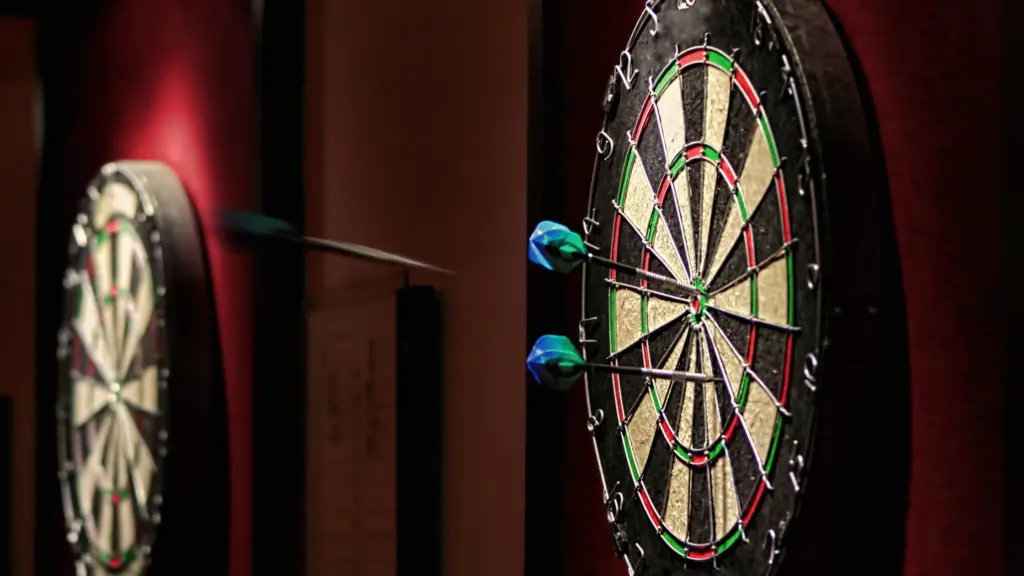
Dart games vary widely in rules and scoring systems, but they all share a common goal: precision and strategy. Whether you’re playing in a casual setting or a competitive tournament, understanding how to score and the diversity of games available can significantly enhance your experience.
Scoring Basics
Scoring in darts is straightforward: hit a target and earn points based on the section you strike. The outer rings provide opportunities for doubles and triples, which means if your dart lands in these areas you’ll score double or triple the points of that section, respectively.
Be cautious, though; if your score exceeds what you need to check out in games like 501 or 301, you’ll bust and your turn’s points won’t count. Properly tracking your score and strategically aiming for the right targets, including the all-important double ring for a game-winning “double out,” is crucial in your dart practice.
Popular Dart Games
Dart games can be as varied as the players themselves, but a few stand out for their popularity and unique challenges:
- Cricket: A tactical game where you must “close out” numbers and surpass your opponent’s score.
- 501 and 301: These are countdown games where you start with a respective score and aim to reach zero, finishing on a double.
- Around the World: This game helps with dart practice by requiring you to hit each number on the board in sequence.
- Shanghai: Each round, players aim for the same number, with the opportunity to end the game with a single, double, and triple in one turn.
- Killer: A competitive game where players “kill” each other’s numbers to be the last one standing.
The rules can be simple or complex, but they all enhance your skill in throwing darts.
Tournament Play
In dart tournaments, the structure is often based on 501 as the standard format. You, as a contender, must be adept at both scoring and tactics, including knowing when to aim for the bullseye (the centerpiece worth 25 or 50 points) versus when to focus on playing it safe with consistent numbers. Tournament rules might also include variations such as Round the Clock, adding an enjoyable yet competitive twist to traditional play. Your ability to adapt to different games and scoring methods will not only be tested but also celebrated in the thrilling world of dart tournaments.
Setting Up and Ensuring Safety
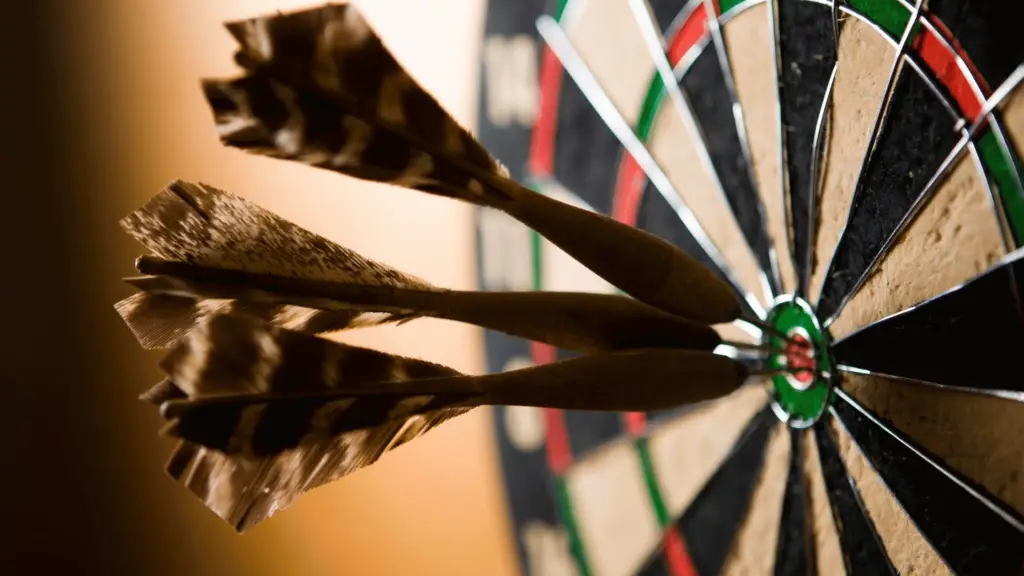
When setting up a home dart area and ensuring safety during play, precise measurements and mindful precautions will protect both players and surroundings.
Home Dart Area
Firstly, select a location in your home that’s away from high traffic areas to minimize disruption and prevent accidents. Your dartboard should be mounted securely on a wall, with the bullseye exactly 5 feet 8 inches from the floor. Considering darts may bounce off the board, it’s wise to have ample space around the dartboard free from fragile objects.
To designate the throw line, or oche, measure 7 feet 9.25 inches from the face of the dartboard if using steel-tip darts. For those with soft-tipped darts, place the oche at 8 feet from the dartboard. Mark it with non-permanent solutions like tape or a removable mat, which also helps protect your floors.
Dart Safety
Always handle darts with care, especially around family and friends. Store your dart set safely out of reach of children when not in use. Dart barrels should be kept tight to prevent darts from disassembling during a throw. Each number on the board represents specific numbered sections, so acquaint yourself with them to avoid misaimed throws.
During play, stand behind the player throwing and retrieve darts only after all have been thrown. Maintaining this discipline ensures no one is at risk of getting hit accidentally.
Remember, the outer bull counts as 25 points, but striving for it shouldn’t compromise safety. After each session, check the board and the wall for any wear and suggest repairs or adjustments as needed.
Frequently Asked Questions
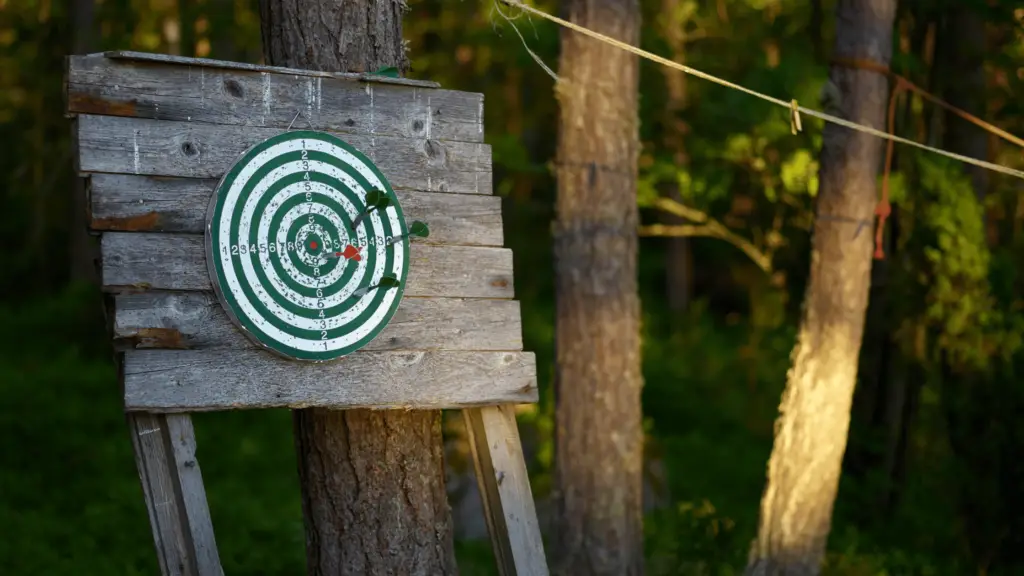
Darts is a game of skill and precision. Here you’ll learn about the basics, from scoring and stance to tips for mastering techniques and choosing the right equipment.
What are the basic rules and scoring methods in darts?
The objective in darts is to reduce a fixed score, commonly 501 or 301, to zero, ending with a double or the bullseye. Each segment on the dartboard has a specific point value, and hits on these segments deduct points accordingly.
How should I stand when throwing a dart for optimal performance?
Your stance should be stable and comfortable. Position your dominant foot slightly forward, and maintain a consistent posture for each throw. For more precise guidance on foot positioning, visit Dart Board Hub.
What are some dart release tips to improve my game?
Release the dart in a smooth, controlled motion, letting the tip lead. Focus on following through with your throwing hand moving directly towards your target. Timing the release can be crucial to your game’s improvement.
What qualities should I look for when choosing darts as a beginner?
Start with a moderate weight dart around 20 to 25 grams, and look for a grip that feels comfortable in your hand. The dart should balance well and suit your throwing style. For detailed advice, explore tips at myDartpfeil.
Where can I find step-by-step instructions to learn playing darts?
To find comprehensive, beginner-friendly instructions, check out resources like DartPicks, where you can delve into various aspects of playing darts, from the basics to more advanced techniques.
Can you provide any professional tips to enhance my darts technique?
Incorporate practice games, focus on your stance and throwing technique, and avoid favoring specific numbers on the board. Professionals suggest being patient and staying positive. For insights from the pros, read through tips at Darts Guide.

